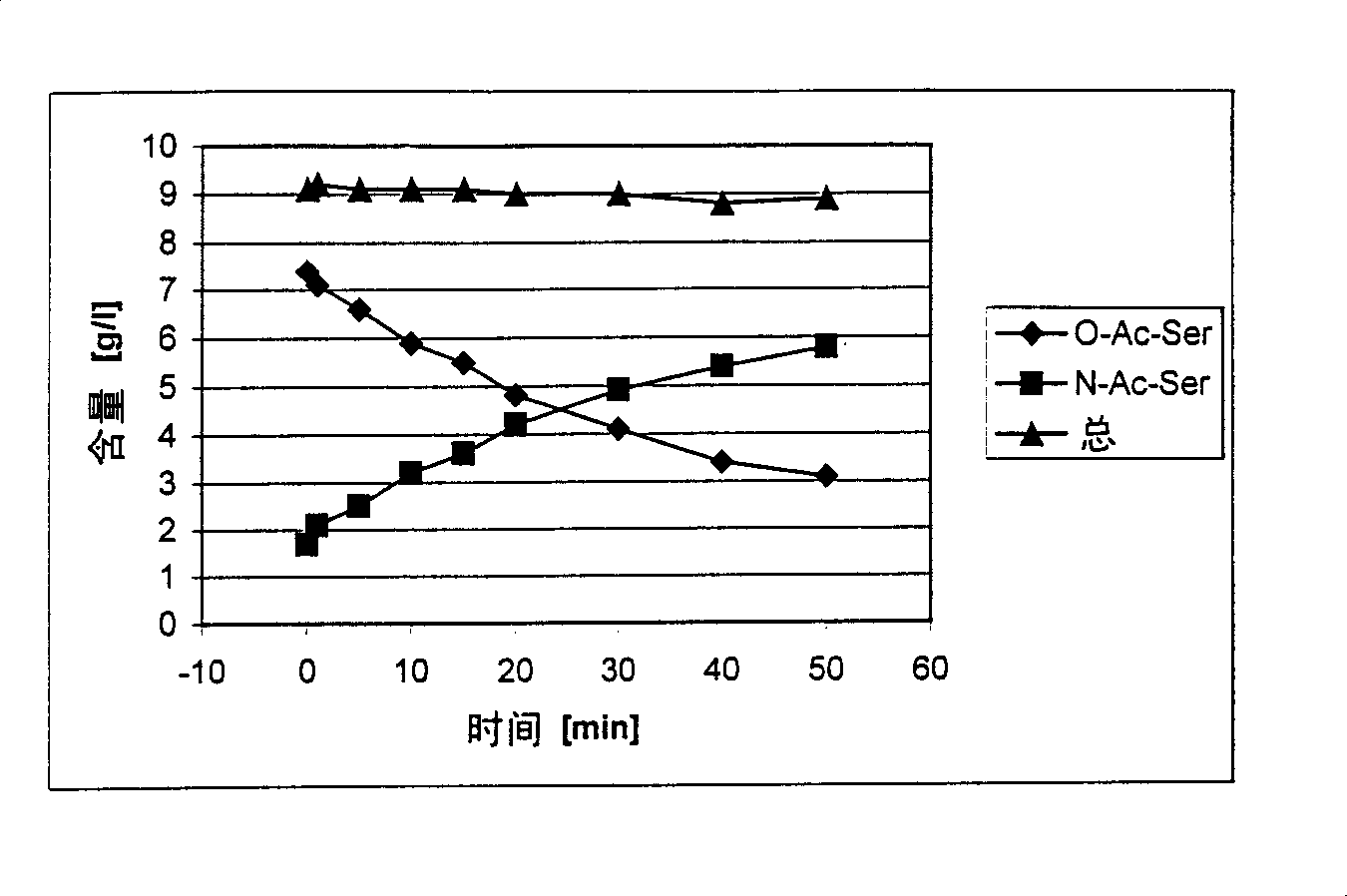Fermentation process of preparing O-acetyl-L-serine
A technology of acetyl and serine, applied in the field of preparation of O-acetyl-L-serine, which can solve the problems of bacterial growth and damage
- Summary
- Abstract
- Description
- Claims
- Application Information
AI Technical Summary
Problems solved by technology
Method used
Image
Examples
Embodiment 1
[0043] To get a more precise idea of the isomerization reaction under conditions close to the fermentation conditions, 0.9 g of O-acetyl-L-serine was introduced into 100 ml of fermentation medium (see Example 3). The pH was then adjusted to 7.0 with 25% ammonia and samples were taken at various times while the reaction temperature was maintained at 32°C. These samples were analyzed by reverse phase HPLC on a LUNA 5[mu] C18(2) column (Phenomenex, Aschaffenburg, Germany). The eluent used was dilute phosphoric acid (0.1 ml concentrated phosphoric acid / l) at a flow rate of 0.5 ml / min. The result is as figure 1 shown. Example 2: Pre-culture of production strains
Embodiment 2
[0044] As a fermented preculture, 20 ml of LB medium (10 g tryptone / l, 5 g yeast extract / l, 10 g NaCl / l), which additionally contained 15 mg Tetracycline / l, cultured with strain w3110 / pACYC184-cysEX-GAPDH-ORF306 (in EP 0885962 A1 corresponding to US Patent Application Serial No. SN 09 / 097759 (which is incorporated herein by reference)). Seven hours later, the entire mixture was transferred to 100 ml SM1 medium (12 g K 2 HPO 4 / l; 3g KH 2 PO 4 / l; 5g (NH 4 ) 2 SO 4 / l; 0.3gMgSO 4 ×7H 2 O / l; 0.015g CaCl 2 ×2H 2 O / l; 0.002g FeSO 4 ×7H 2 O / l; 1g sodium citrate × 2 H 2 O / l; 0.1g NaCl / l; 1ml trace element solution / l, this solution consists of 0.15g NaCl 2 MoO 4 ×2H 2 O / l; 2.5gNa 3 BO 3 / l; 0.7g CoCl 2 ×6H 2 O / l; 0.25g CuSO 4 ×5H 2 O / l; 1.6g MnCl 2 ×4H 2 O / l; 0.3g ZnSO 4 ×7H 2 O / l composition), wherein supplemented with 5g glucose / l; 0.5mg vitamin B1 / l and 15mg tetracycline / l. Subsequent cultivation was performed at 30° C. and 150 rpm for 17 hours. Example ...
Embodiment 3
[0045] The fermentor used was a Biostat M unit supplied by Braun Biotech (Melsungen, Germany) with a maximum culture volume of 2 l. The fermenter contains 900ml fermentation medium (15g glucose / l; 10g tryptone / l; 5g yeast extract / l; 5g (NH 4 ) 2 SO 4 / l; 1.5g KH 2 PO 4 / l; 0.5g NaCl / l; 0.3g MgSO 4 ×7H 2 O / l; 0.015g CaCl 2 ×2H 2 O / l; 0.075gFeSO 4 ×7H 2 O / l; 1g trisodium citrate × 2 H 2 0 / l and 1 ml trace element solution (see above) / l, 5 mg vitamin B1 / l and 15 mg tetracycline / l, with 25% ammonia to adjust the pH to 6.0), the fermentor was used as described in Example 2 Precultures were inoculated (optical density at 600 nm of approximately 3). During the fermentation, the temperature was set at 32° C. and the pH was kept constant at 6.0 by metering in 25% ammonia. Fill the culture with sterile compressed air at a rate of 1.5 vol / vol / min, and the stirring rate of the stirrer at 200 rpm. After the oxygen saturation decreased to 50%, the speed of the stirrer was incre...
PUM
 Login to View More
Login to View More Abstract
Description
Claims
Application Information
 Login to View More
Login to View More - R&D
- Intellectual Property
- Life Sciences
- Materials
- Tech Scout
- Unparalleled Data Quality
- Higher Quality Content
- 60% Fewer Hallucinations
Browse by: Latest US Patents, China's latest patents, Technical Efficacy Thesaurus, Application Domain, Technology Topic, Popular Technical Reports.
© 2025 PatSnap. All rights reserved.Legal|Privacy policy|Modern Slavery Act Transparency Statement|Sitemap|About US| Contact US: help@patsnap.com

